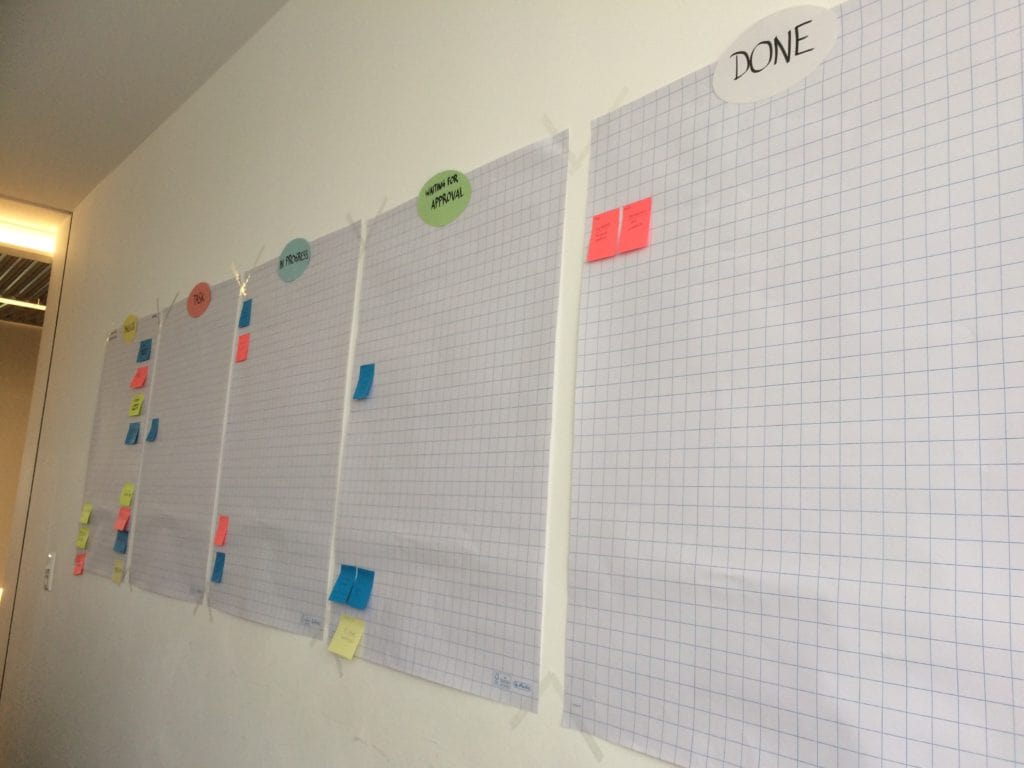
Agile development at Palmer Hargreaves. In future, jobs will be divided into different statuses via an Agile Board: Backlog, Tasks, In Progress, Waiting for Approval and Done. As soon as a job (package) arrives, it goes into the backlog. These are divided into Active and Non-Active. As soon as a job (package) is active, individual job tasks are defined from it. These are flagged with stickers to indicate which employees are responsible for those tasks. As soon as this employee implements the task, the status is set to "In Progress". Once the task has been completed, it moves to the status "Waiting for Approval" and must be approved internally or by the customer. As soon as the task has been approved, it moves to the last status: Done. This is a very good way of showing which and how many work packages are available, who is taking over which task and what the current status is. In the morning, a daily stand-up is used to inform the other employees about the current status and to define the tasks for the current working day. In addition, it should be clarified whether the tasks are clearly defined and whether there are any blockers or other obstacles that could lead to problems during implementation.
In addition, there will be more focus on design thinking and lean UX in the future:
Design Thinking
is a process developed to promote creative ideas. Similar to user-centred design (UCD), the design thinking method focuses on producing innovations that are oriented towards the user and satisfy their needs.
Design thinking works explicitly user-oriented and is based on these four essential components: Iterative process, own values, interdisciplinary teams and mobile room concepts:
1. Iterative Process:
Understanding: the first step is to understand the problem, which leads to the choice of an appropriate question that defines the needs and challenges of the project.
Observing: this is followed by intensive research and field observation to gain important insights and findings and to define the framework of the status quo.
Point-of-view: the observations made are then broken down to a single, prototypical user (persona) whose needs are condensed into a clearly defined brainstorming question.
Ideation: this step is one of the core elements of design thinking and consists mainly of brainstorming, which serves to develop and visualise different concepts.
Prototyping: to test and illustrate the ideas, initial, low-effort prototypes are developed and tested on the target group.
Refinement: based on the insights gained through prototyping, the concept is further improved and refined until an optimal, user-oriented product is created. This iteration step can refer to all previous steps.
2. Own Values:
- Be visual
- One conversation at a time
- Encourage wild ideas
- Defer judgement
- Go for quantity
- Stay on topic
- Build on the ideas of others
3. Interdisciplinary teams
These can be professional, but also cultural, national or simply age and gender differences. The decisive factor is the multi-layered view of a topic.
4. Mobile room concepts
Space plays a big role in design thinking. However, working while standing, writing on whiteboards and mobile space concepts are all part of design thinking.
The lean ux approach fits in with the interdisciplinary teams:
Lean UX:
- Interdisziplinäre Teams
Results and its goals (story points = tracking more logins, less drop-outs, user activity), A/B tests. Specifically which features and measures achieve the goal.
Minimise activities that do not contribute to the success of the product. Avoid extensive documentation, long meetings. Rather simple wireframes, short meetings to bring everyone up to speed.
Small work packages Develop an MVP (Minimal Viable Product) first. Allows to proceed iteratively and to check at any time whether the developed features achieve the intended results. Unnecessary features are thus avoided and problems are identified at an early stage.
Continuous learning from success and failure and to improve. At the beginning is the brainstorming (Think). Product version or prototype creation (Make) and hypothesis testing (Check). The findings and learnings flow into the next iteration. This is how a continuous learning and improvement process can begin.
“Doing” instead of analysing. Doing is more important in Lean UX than analysing. Make a hypothesis and find a way to test it quickly and easily = create a prototype and test it with real users. Afterwards you have new insights and knowledge. Implement new versions quickly and collect feedback instead of planning everything perfectly from the beginning.
Learning before growth. With products, it is often not at all clear what exactly customers need and what they are willing to pay for. In this phase, individual functions are often changed. In close contact with the users, hypotheses have to be created and tested. Only when you have found what the market wants is it worth investing in scaling.
Failures are allowed. Failure is part of the Lean UX principle. The sooner you realise that a path is the wrong one, the less waste there will be. Learn lessons for the future.
No comments.